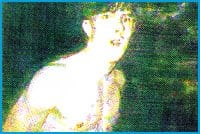My attitude toward the AIDS quilt was always a bit haughty and dismissive, probably best summed up by Matt Parker and Trey Stone in their song “Everyone Has AIDS” from Team America: World Police and its lyric, “Come on, everybody, we’ve got quilting to do!”
There’s something about crafting in the face of a pandemic that struck me as perhaps not the best mobilization of energies. I suppose that made me an ideal audience for Andrea Bowers’ show at the Power Plant, The Weight of Relevance, in which over the course of a three-channel video installation, some documentary photo-graphy and fragments of the quilt itself she ponders the plight of the now-beleaguered quilt and the attempts of its dwindling caretakers (its maintenance staff of 52 has been whittled down to an embattled 10) to maintain its relevance as a document and an activist icon.
Prior to this show my contact with the quilt was as indirect as you could possibly get, entirely through photos of its original assembly on the Mall in Washington, DC. So I was unprepared to encounter the actual thing and its tidal wave outpourings of loss, grief and memory. It’s surely the most powerful part of the show. The documentary aspects of the installation are informative enough but because they can’t give you access to the quilt itself (all 54-odd tons of it), they only register at an intellectual level.
The wall-sized excerpt carries all the emotional resonance of the show and it’s certainly responsible for my total rethink of the quilt. For one thing its physical presence is literally overwhelming. The section covers a huge wall and is only a fraction of the entire object. But more importantly it allows you to interact with it on a human scale, and this is the weight of its relevance to which Bowers refers.
Each one of these patches is an attempt to come to grips with an entire life through very humble means. Neither monumental nor austere (least of all the one with the felt appliqué pig in leather gear) each piece’s humour, warmth and sometime-tackiness are highly evocative of a human life and of people coping with its loss. The relevance of the quilt hits you straight in the gut.
the gut-hitting continues in the upstairs gallery where _Stephen Andrews has installed his latest foray into animation, the brusquely titled Cartoon. Andrews has been mining the internet for still images and footage from the Iraq war. He translates those images as crayon drawings, done by superimposing layers of colour one atop the other. Andrews then uses these drawings as individual cells in a longer animation.
The installation lets you see just what a labour-intensive project this is. The finished 45-second animation plays in one corner of the gallery while the opposite wall is literally covered, edge-to-edge, floor-to-ceiling, with the hundreds upon hundreds of individual drawings that were used to create it.
The animation begins with a sun-bleached desert horizon and the aggressive soundtrack of pounding drums. A blotch appears on its edge and, as it makes its way toward and past you, it becomes a giant truck. The scene then cuts to a deer being run over, and then cuts again, lingering on a young shirtless man, frozen and illuminated by a camera flash.
Both the metaphor and what it’s alluding to are fairly obvious: militarism, young men, deer in headlights. Andrews is in pretty iffy territory — I don’t think any of us need reminding that war is bad — but he is capable and intelligent enough to navigate it seamlessly. He embraces with unflinching force the severity of his content and drives home his message with equal fury.
He isn’t content to show you the deer in the headlights and leave it at that. No, he has the truck roll clean over the deer, its hooves sailing into the air, then being swallowed under the maw of the vehicle. This isn’t a dainty metaphor; it’s a blunt statement, brilliantly and succinctly uttered. It’s surely the strongest political art I’ve seen recently and, taken together with the AIDS quilt in the downstairs gallery, nothing less than a call to arms.

 Why you can trust Xtra
Why you can trust Xtra


